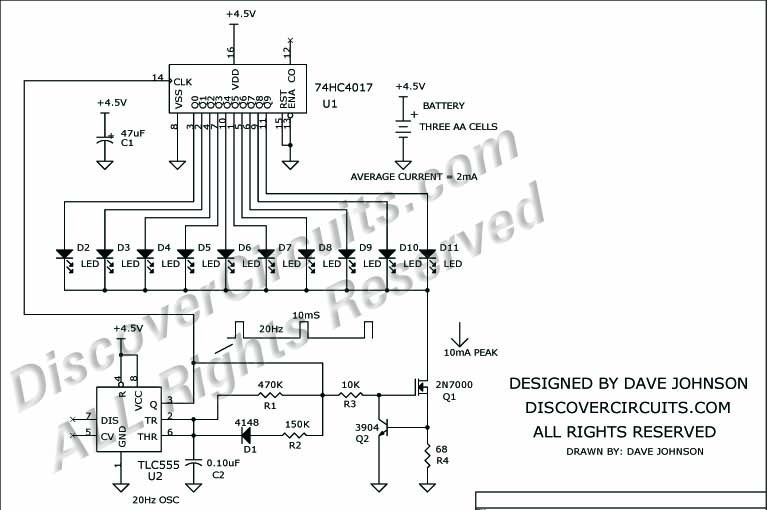|
DiscoverCircuits.com -- Hobby Corner
Last Updated on:
Tuesday, June 01, 2021 03:06 PM
Hobby Circuits List
The contents &
graphics of Discovercircuits.com are copyright protected.
LINK to Dave's circuit, but DO NOT COPY any files to your WEB
SITE server |
 |
|
|
|
|
|
|
More LED Circuits
LED Flasher Circuits |
|
Reduced Power Sequential LED Flasher
designed
by David A. Johnson, P.E.
December 1, 2008 |
| The
74HC4017 is a neat decade counter which has 10 decoded outputs. When supplied
with a low frequency clock and with a LED attached to each of the outputs, an
interesting ten step sequential flasher effect can be produced. The LEDs can
be configured in a wide variety of patterns of loops, lines or arrows. But,
these circuits can often be power hogs. |
|
|
To
reduce the average current needed to produce the same effect, you can strobe the
individual LEDs with a short 10mS pulse.
The
circuit shown below uses a CMOS
version of the 555 timer to produce a 20Hz clock, with
10 millisecond output pulses. The 20Hz frequency means the 74HC4017 IC completes a
ten LED sequence twice each second. Slower sequences are possible by increasing the
value of R1. |
|
With
the parts shown, the LED peak current is about 10ma with an average current of about
2 milliamps. A set of 3 alkaline AA cells should power the circuit for about
500 hours. This is 5 times longer than without the LED strobing method.
With a solid 4.5 volts from the three AA cells, any LED color can be used. By
restricting the color of the LEDs to only red devices, the circuit can be operated
at 3 volts, with just two AA cells. The average current can be reduced even more by
lowering the clock frequency or by decreasing the peak LED current. Many high
efficiency LEDs produce very useable light with just 2ma of current. To program for
2ma of peak LED current, change R4 from 68 ohms to 330 ohms.
If
you would like to have more than 10 LEDs in a flashing sequence, you can string
multiple 74HC4017 ICs in series. I will post such a design later.
|
|
|
|
|
Click on Circuit Below to view PDF of Schematic |
|
 |
|
|
|
More LED
Circuits LED Flasher Circuits
Hobby Circuits List
eMail David A.
Johnson, P.E. about this circuit |
|
|